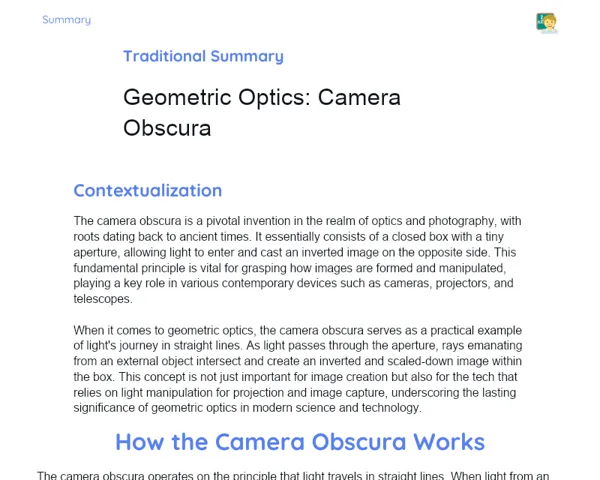Summary Tradisional | Simple Harmonic Motion: Simple Pendulum
Contextualization
Simple Harmonic Motion (SHM) is a key concept in Physics that describes a type of motion that repeats itself over time, where the force that brings it back to its original position is directly proportional to how far it is from that position and acts in the opposite direction. This kind of motion can be seen in many natural and man-made occurrences, making it vital for grasping oscillatory systems. The simple pendulum is a classic instance of SHM, where a weight linked to a non-stretchable string swings as a result of gravity. For small angles of swing, the simple pendulum shows motion that can be explained by the equations of SHM, making it easier to study its dynamic properties.
Understanding the simple pendulum is not just about theory; it has real-world applications too. Back in the 17th century, the scientist Christiaan Huygens developed the concept of the simple pendulum to create a pendulum clock, which for many years was the standard for accurate timing. Additionally, pendulums are crucial in devices like seismographs to measure earthquakes, proving their ongoing importance in contemporary science. Therefore, studying the simple pendulum not only enhances our grasp of fundamental physics concepts but also demonstrates how these principles play a role in technologies that influence our daily lives.
To Remember!
Definition of Simple Harmonic Motion (SHM)
Simple Harmonic Motion (SHM) refers to a type of oscillatory motion where the restoring force directly correlates with the displacement and acts in the opposite direction. This force continuously works to bring the object back to its balance point. The equation representing this force is F = -kx, where F is the restoring force, k is a proportionality constant (commonly known as the spring constant), and x represents the displacement from the equilibrium position.
In SHM, the object's acceleration is directly linked to the displacement and works against it, resulting in periodic motion. This can be depicted using sine and cosine functions, which solve the differential equation that governs SHM. Key characteristics of SHM include its amplitude, period, and frequency.
Amplitude indicates the maximum distance from the equilibrium position; the period is the time taken for one full oscillation, while frequency refers to the count of oscillations per unit time. These characteristics help to thoroughly describe how an oscillatory system behaves within SHM.
Common examples of SHM include how springs and pendulums oscillate with small displacements. A good understanding of SHM is crucial for analyzing various physical systems that display oscillatory behaviour.
-
Restoring force is proportional to the displacement and acts in the opposite direction.
-
Equation F = -kx.
-
Acceleration is proportional to the displacement and opposite to it.
-
Periodic motion can be described using sine and cosine functions.
Simple Pendulum
The simple pendulum is made up of a mass m (referred to as the bob) hanging from a non-stretchable string of length L, which swings due to the force of gravity. When it is pulled from its rest position and then released, the pendulum swings in an arc. For small oscillation angles (usually less than 15 degrees), the pendulum’s motion can be roughly described by Simple Harmonic Motion (SHM).
The restoring force acting on the mass comes from the weight's component that is in the direction of the movement. This force is proportional to the angular displacement and acts in the opposite direction, which aligns with the characteristics of SHM. The period of this simple pendulum is described by the equation T = 2π√(L/g), where T is the period, L is the string's length, and g is the gravitational acceleration.
This approximation holds true for small angles because, in these situations, the relationship between the angular displacement and the restoring force is linear. However, for larger angles, this relationship becomes nonlinear and the motion can't be accurately described using SHM equations.
Understanding the simple pendulum is crucial for grasping concepts in dynamics and gravitation. Moreover, it has practical uses such as in pendulum clock constructions and measuring gravitational acceleration.
-
Involves a mass suspended by a non-stretchable string.
-
Swings as a result of gravity.
-
For small angles, its motion is approximated by SHM.
-
The period formula is T = 2π√(L/g).
Equations of the Simple Pendulum
The equations that describe the motion of a simple pendulum come from the principles of SHM for small oscillation angles. The period equation for the simple pendulum is T = 2π√(L/g), where T is the oscillation period, L is the string's length, and g is the acceleration due to gravity. This formula shows that the period depends solely on the length of the string and the acceleration due to gravity, irrespective of the bob’s mass.
To derive this equation, we look at the restoring force acting on mass m. This force represents the tangential component of weight, approximated as F ≈ -mgθ for small angles θ, where θ is the angular displacement in radians. The motion equation of the pendulum closely resembles that of SHM.
Beyond the period, other useful equations include those for angular velocity ω and angular acceleration α. Angular velocity peaks when the pendulum is at the equilibrium position and is zero at the extremes of the motion. Conversely, angular acceleration is maximum at the extremes and zero at the equilibrium position.
These equations are vital for tackling practical problems involving simple pendulums, such as calculating the oscillation period, determining string length, or finding gravitational acceleration in a particular area.
-
The period formula is T = 2π√(L/g).
-
Restoring force approximated as F ≈ -mgθ for small angles.
-
Maximum angular velocity occurs at the equilibrium position.
-
Maximum angular acceleration occurs at the extremes of motion.
Problem Solving
When solving problems related to simple pendulums, it's usually necessary to apply SHM equations. A common problem might involve calculating the period of a pendulum with a specified string length and gravitational acceleration value. To solve, we use T = 2π√(L/g) and plug in the known values to determine the period.
Another type of problem could ask for the string's length given the period of oscillation and gravitational acceleration. In this case, we can rearrange the period equation to find L = (T²g)/(4π²). We substitute the known values to calculate the string length.
Additionally, a question might request the gravitational acceleration in a region based on the length of the string and the pendulum's period. Here, we isolate g in the period equation, ending up with g = (4π²L)/(T²), and substitute the known values to find the gravity acceleration.
These kinds of problems are excellent for reinforcing students' understanding of pendulum equations and the practical application of SHM concepts. Working through various problems effectively tests students' comprehension and nurtures critical analytical skills.
-
Applying SHM equations when solving problems.
-
Calculating period, string length, and gravitational acceleration.
-
Rearranging equations to find unknown quantities.
-
Reinforcing understanding through practical problem-solving.
Key Terms
-
Simple Harmonic Motion (SHM): Periodic motion where the restoring force is proportional to the displacement and acts in the opposite direction.
-
Period (T): Time taken to complete one full oscillation.
-
Amplitude: Maximum distance from the equilibrium position.
-
Simple Pendulum: A weight hanging from a non-stretchable string that swings because of gravity.
-
Acceleration due to Gravity (g): The acceleration of an object due to the gravitational force, usually about 9.8 m/s² on Earth.
-
Pendulum Period Equation: T = 2π√(L/g), which connects the oscillation period to the string length and gravitational acceleration.
-
Angular Displacement (θ): The angle of movement from the equilibrium position.
-
Angular Velocity (ω): The rate at which angular displacement changes.
-
Angular Acceleration (α): The rate at which angular velocity changes.
Important Conclusions
In this lesson, we delved into Simple Harmonic Motion (SHM) and its role in the simple pendulum. We've learned that SHM is a repetitive motion where the restoring force relates to the displacement and acts in the opposite direction. For the simple pendulum, small oscillation angles allow this force to be approximated, letting us describe the motion using SHM equations.
We've also discovered that the period equation for the simple pendulum, T = 2π√(L/g), is essential for calculating the oscillation period, string length, or gravitational acceleration. This knowledge is crucial for addressing practical problems and comprehending the dynamics of oscillatory systems. Plus, we touched on the historical significance and practical applications of the pendulum, from precision clocks to seismographs.
Recognising the extensive applications of this topic across various sectors of science and technology highlights its importance. Grasping the simple pendulum and SHM not only enhances our theoretical knowledge but also enables us to apply these concepts in practical situations. I encourage everyone to keep exploring this captivating subject in Physics.
Study Tips
-
Revisit the core equations of Simple Harmonic Motion and the simple pendulum. Work on problem-solving to entrench your understanding.
-
Watch videos and conduct practical demonstrations that showcase the motion of a simple pendulum. Visualising the concept can greatly enhance comprehension of the theories discussed.
-
Explore other examples of SHM, such as the oscillation of springs, to broaden your understanding of oscillatory systems and identify shared traits and differences.



